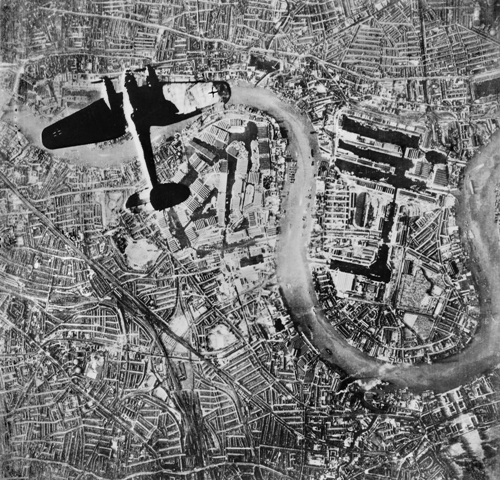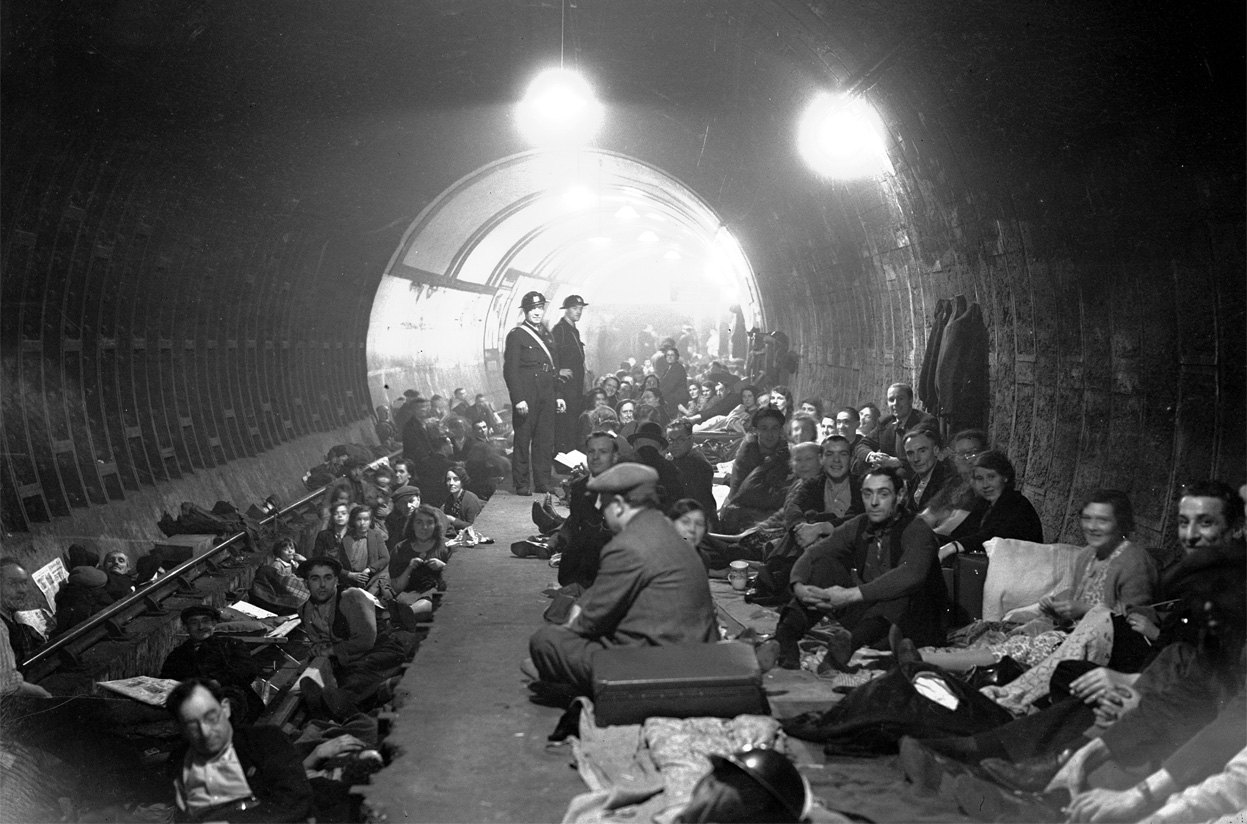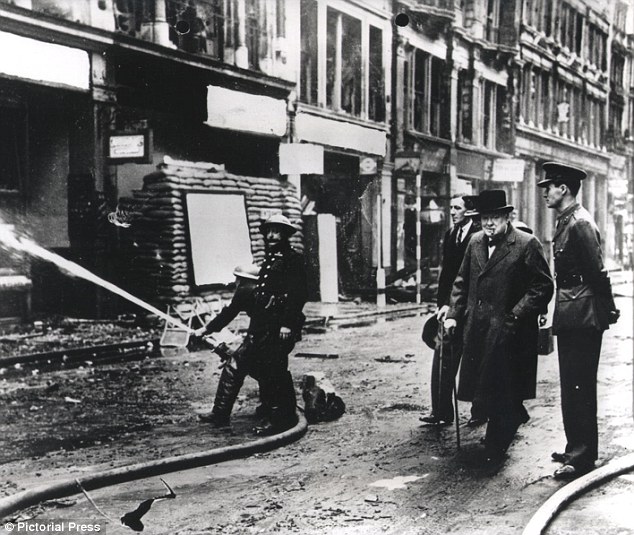“I felt as if I were walking with Destiny, and that all my past life had been but a preparation for this hour and for this trial.”
—Winston Churchill*
Excerpt from Kairos: How Great Men and Women Made History

A Heinkel He III bomber flying over Wapping and the Isle of Dogs at the start of the London Blitz, 7 September 1940 (C) IWM
It was a bomber’s moon. Full and bright, it illuminated the silvery thread of the River Thames thousands of feet below the boots of the German Luftwaffe pilots nosing their droning bombers through the crystalline night sky over blacked-out London. The mirrored glaze of waterway splitting open the great grassy chalk flats of south-eastern England shone through what Joseph Conrad called the “mournful gloom” rising from the river itself and “brooding motionless over the biggest, and the greatest, town on earth.” (1) The beckoning river served as a welcome navigational aide for German pilots seeking targets on either side of the river far below. A confusion of fires lit by incendiary bombs carpeted the landscape below like sapphire wild flowers, each smoke column weaving itself into a blanket of primordial darkness not seen since Roman soldiers lit the first cookfires in their rugged fortifications built on the black tidal mud in 43 AD. Only now the fires encompassed entire city blocks and the smoke rose among the beams of searchlights swaying across the dark horizon like enormous stalks of grass blowing in a silent wind.
Still the famous river, proudly branded a decade earlier as “liquid history” by one member of Parliament, needled its way through the heart of London and lapped at the stony foundations of the Palace of Westminster, once the royal home of Norman kings and the epicenter of British governance for almost a thousand years. Downstream, the portcullis gate of the Tower of London bit into the river just as it once had closed behind the backs of prisoners disembarking for a final stop at the executioner’s block. From there, the river flowed under London Bridge in its fall toward Tilbury docks 25 miles below where it swung around the vast flat hook of the North Kent Marshes before dropping below Southend-on-Sea into the open sea channel beyond.
Across the channel, only 21 miles wide at its narrowest point and filled with German U-boats lurking below long chains of floating mines, lay what Winston Churchill, the newly ensconced prime minister, called in his anachronistic style “the great aerodromes of Central Europe.” The Nazi bombers crossing the night sky above London had launched from those airfields 90 minutes earlier, exactly as Churchill had predicted in a broadcast in 1936. Then he had been a political outcast and a lone voice of opposition to the popular pacifist policies of the time. Churchill’s earlier message appeared prescient now:
“At present we lie within a few minutes’ striking distance of the French, Dutch and Belgian coasts, and within a few hours of the great aerodromes of Central Europe. We are even within canon-shot of the Continent. So close as that! Is it prudent, is it possible, however much we might desire it, to turn our backs upon Europe and ignore whatever may happen there?” (2)
But those who held the reigns of power in the British government during the years of Hitler’s rise—Ramsay McDonald, Stanley Baldwin, Neville Chamberlain, Lord Halifax—had turned their backs in favor of more popular domestic policies. They had ignored the growing problems in Europe and appeased Hitler’s bullying methods until it was too late.
It was 1940 now, and London was breaking apart at the seams as bomb after bomb hammered the old city night after night. The first bombs to fall on London since WWI (then they had been delivered by slow-moving plywood Gotha airplanes and eerily large Zeppelin airships) came quite by accident—at least by German accounts—on August 24 after Luftwaffe crews veered off course, although no one on the ground, including Churchill, believed it had not been intentional. Churchill hit back immediately, unleashing 40 British bombers to Berlin the next night.
This incensed Hitler. He publicly announced that the Germans were only targeting industrial sites and had assured the German people that no British bombs could touch them. Before a vast crowd of cheering Berlin women he threatened to drop “150, 180, 230, 300 or 400 thousand kilos, or more, in one night” upon the British. “If they declare that they will increase their attack on our cities, then we will raze their cities to the ground. We will stop the handiwork of those night-pirates, so help us God! The hour will come when one or the other of us will crumble, and that one will not be National Socialist Germany.” (3)
On September 7, the bombs began to rain out of the night sky over London like a plague of Egypt. The first raid lasted ten hours. Church bells pealed a warning across England in expectation of a German amphibious land invasion—the dreaded Operation Sea Lion. (4) No ground troops came but for 57 consecutive days and nights the bombs fell and came to be known as “The Blitz,” borrowed and shortened from the German blitzkrieg. Almost 24,000 tons of high explosive munitions were dropped in 85 major raids. The Germans would not stop bombing until the end of May the following year. Approximately 2.5 million Britons would lose their homes at some point before the end of the bombing, 43,000 would die, and more than 70,000 would be injured, nearly ten percent of them children. (5)(6) It was war at its worst, and its sudden arrival struck a near-fatal blow at the very heart of the once-impregnable British Empire.

Londoners staked out the prime real estate of station platforms of the London Underground, such as Aldwych shown here, or slept in human chains between the subway tracks until operators cleared them to switch the current back on at 4:30 a.m.
Every night Londoners huddled together in cramped cellars and basements and air raid shelters, or, if they had enough space in a garden, one of the corrugated metal Anderson shelters distributed by His Majesty’s Government free of charge if one made less than £5 a week. They staked out the prime real estate of station platforms of the London Underground, bedrolls and picnic baskets in hand, or slept in human chains between the subway tracks until operators cleared them to switch the current back on at 4:30 a.m. (7) They emerged in the morning from under bridges to find their homes replaced by craters and rubble, or commuted to work in the dark past the charred bodies of neighbors still smoking from the heat of their impact with destiny the night before.
But instead of melting into panic and chaos, as the Germans hoped (and many British leaders expected), the stout-hearted British embraced the terror. “It is a curious fact about the British Islanders,” Churchill observed, “who hate drill and have not been invaded for nearly a thousand years, that as danger comes nearer and grows, they become progressively less nervous; when it is imminent, they are fierce; when it is mortal, they are fearless.” (8) Exhausted, sore and on edge from staring Death in the face night after night, they began to savor the simple joys in life. Many came to prefer the comforts of their own home or the traditionally silent retreat of a favorite club during air raids instead of withdrawing underground. They crowded together to drink in corner pubs or ordered meals from restaurant menus reduced in size by mandated food rationing. Parents who had evacuated their children to safer sites abroad or in the English countryside sent word for them to return, preferring to spend their last hours, if they came, knitting, reading or playing records on a gramophone among family members gathered around the parlor fire. Ordinary people from all walks of life joined the Home Guard, the Air Raid Precautions service, the Women’s Voluntary Services for Civil Defence, or the Auxiliary Fire Service. Eighty men and women made up a volunteer fire brigade to protect the Christopher Wren-designed St. Paul’s Cathedral from the flames. A cohesive air of “Blitz spirit”—resilience, defiance, stoicism, a stiff upper lip—unified previously incongruous elements of British society. A bomb falling four miles out of the sky—approximately 35 seconds of screeching terror—did not distinguish among the stratified social classes. Buckingham Palace suffered nine direct bomb hits over the course of the Blitz, on several occasions while King George VI, Queen Elizabeth and other members of the royal family were in residence. They were all in this together.
 Churchill, years later on his 80th birthday, standing amid banks of decorative flowers on the steps of Westminster Hall, recalled in triumph how the British embraced this Blitz spirit during their darkest hour. “Their will was resolute and remorseless and, as it proved, unconquerable.” It was the sound of his voice that had marshaled them to fight in the darkest moment of that hour when they first realized they stood alone against the crush of advancing Nazi armies. “It fell to me to express it, and if I found the right words you must remember that I have always earned my living by my pen and by my tongue. It was the nation and race dwelling all round the globe that had the lion heart. I had the luck to be called upon to give the roar.” (9)
Churchill, years later on his 80th birthday, standing amid banks of decorative flowers on the steps of Westminster Hall, recalled in triumph how the British embraced this Blitz spirit during their darkest hour. “Their will was resolute and remorseless and, as it proved, unconquerable.” It was the sound of his voice that had marshaled them to fight in the darkest moment of that hour when they first realized they stood alone against the crush of advancing Nazi armies. “It fell to me to express it, and if I found the right words you must remember that I have always earned my living by my pen and by my tongue. It was the nation and race dwelling all round the globe that had the lion heart. I had the luck to be called upon to give the roar.” (9)
(1) Joseph Conrad, Heart of Darkness, as quoted in M. H. Abrams, ed., The Norton Anthology of English Literature, 7th ed. (New York, London: W. W. Norton and Company, 2001), 2304.
(2) WSC, Broadcast, 16 November 1934.
(3) William L. Shirer, This is Berlin (Hutchinson, 1999), 394-5.
(4) Peter Stansky and William Abrahams, London’s Burning: Life, Death and Art in the Second World War (Stanford University Press, 1994), 33.
(5) Tom Geoghegan, “Did The Blitz Really Unify Britain,” BBC News Magazine, 8 September 2010.
(6) Richard Holmes, In the Footsteps of Churchill; A Study in Character (Basic Books, 2005), 219.
(7) Margaret Gaskin, Blitz: The Story of December 29, 1940 (Harcourt, Inc, 2005), 63.
(8) WSC, The Second World War, Vol 1: The Gathering Storm (New York: Houghton Mifflin Company, 1948), 354.
(9) WSC, Speech, 30 November 1954.
*WSC, Storms, 666
